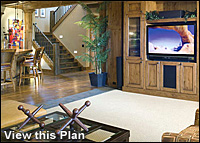New on the Green Scene

Consumers' interest in being green continues to grow, particularly when it comes to home products. Not only are the latest eco-friendly home products good for the environment, but they look great and work great. From energy-efficient light bulbs to solar-paneled roofs, consumers continue to gravitate to green products when building their new home, thanks in part to manufacturers, builders, and architects encouraging the use of green products.
Interest in being green continues to spread, thanks to groups like the NAHB (National Associate of Home Builders) and USGBC (U.S. Green Building Council), government programs like ENERGY STAR and WaterSense and of course the rising cost in energy prices which have forced homeowners to reevaluate their home purchases and daily habits.
Here are some of the latest top eco-friendly home trends and products:
- Copper and copper alloys, such as brass and bronze, are showing up on roofs, entryways, facades, gutters, and downspouts. Despite being quite pricey to purchase and install, they're seen as a good long-term investment because they tolerate inclement weather and are completely recyclable. A copper roof that's installed properly will last over 100 years versus a composition roof that may last only 30 years.
- Timber framing requires significantly less lumber than the traditional "stick-built" housing and almost always incorporates superior insulating panels (SIPS), which keeps heat and air conditioning from escaping the house. There's less waste when large timbers are used, compared with conventional construction that produces sawdust and waste every time a 2-by-4 stud is planed.
- Low-emittance (Low-E) windows, doors, and skylights offer natural light while blocking the sun's UV rays that heat up the inside of a home. The special low-E glazing also stops the sun from fading fabrics, wall coverings, and artwork.
- Rainwater holding tanks are great for capturing rainwater so that they can be used in other ways, such as watering the yard or flushing toilets.
- LED lighting (LED stands for light emitting diodes) is a semiconductor that emits light when an electric current is applied. One big, green advantage is that it contains no hazardous chemicals, like compact fluorescents that contain mercury and incandescent bulbs that give off gasses. In addition, LED fixtures use 80 percent less energy than a traditional incandescent light bulb and can last up to 20 years.
- Toilets account for one third of the water wasted in American homes every day. WaterSense toilets use 30% less water, and are tested for efficiency and performance. The average American flushes the toilet nearly 140,000 times a year, and with a WaterSense labeled toilet, you can reduce the number of gallon wastes by 4,000. Savings with a WaterSense toilet add up to about $90 a year, and provide an easy way to conserve water resources.
- Things have really started cookin' in the kitchen with a wide selection of high-tech green ovens and stoves. New gas ovens have electronic ignition systems, which save about 30% more energy than older models fitted with a pilot light. Combination appliances such as full-size ovens combined with smaller "toaster" ovens save energy by occupying the space of one appliance while delivering the utility of two! When it comes to electric burners, new technology using radiant elements under ceramic glass are far more energy-efficient than the old coil element cooktops. The innovation of induction elements— which transfer electromagnetic energy directly to the pan where the heat is needed— cut energy requirements in half.
- Bamboo and cork are great floor options. Cork is a 100% renewable resource, harvested from the bark of living cork oak trees and bamboo is a sustainable, harvested grass that regenerates at least 8x faster than hardwood. Both are beautiful, sustainable and low-maintenance flooring materials, so it's only a matter of personal taste.
- Green furniture is the latest buzz. Basically, Green Furniture refers to furniture that is eco-friendly and environmentally safe. The most common types of products are made from FSC Certified Wood, reclaimed materials, bamboo, rattan and recycled materials.

 Consumers' interest in being green continues to grow, particularly when it comes to home products. Not only are the latest eco-friendly home products good for the environment, but they look great and work great. From energy-efficient light bulbs to solar-paneled roofs, consumers continue to gravitate to green products when building their new home, thanks in part to manufacturers, builders, and architects encouraging the use of green products.
Consumers' interest in being green continues to grow, particularly when it comes to home products. Not only are the latest eco-friendly home products good for the environment, but they look great and work great. From energy-efficient light bulbs to solar-paneled roofs, consumers continue to gravitate to green products when building their new home, thanks in part to manufacturers, builders, and architects encouraging the use of green products.